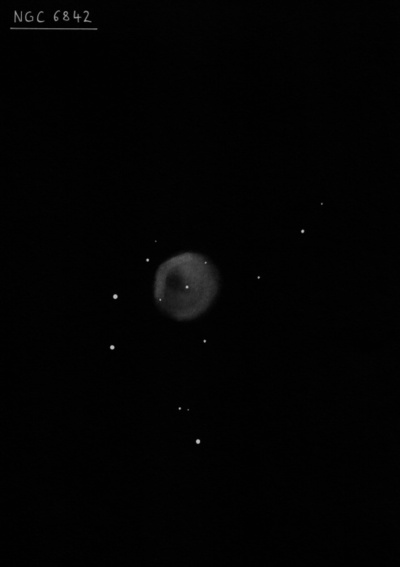
Albert Marth discovered NGC 6842 = m 403 = Sf 43 on 28 Jun 1863 and noted "vF, pL, R." Heinrich d'Arrest independently discovered it the following year on 26 Aug 1864 while searching for William Herschel's H. II-202 = NGC 6847. Truman Safford found the planetary again on 12 Jul 1866 with the 18.5-inch Clark refractor at Dearborn Observatory. See NGC 6847.
In 1919, Heber Curtis reported it was undoubtedly a planetary nebula based on a Crossley photograph and described it as "Very faint. It is about 50" x 45", showing traces of an irregular ring formation. It has a central star of about the 13th magnitude."
200/250mm - 8" off-axis mask (7/28/19): at 107x; very faint but definite unfiltered as a fairly small (~45"), roundish glow. Visible with direct vision when I added a NPB filter.
8" (9/81): I was surprised to glimpse NGC 6842 from home in El Cerrito (limiting mag of 4.5) using a Daystar 300 filter at 125x, even with black hood, averted vision and concentration. Walter Scott Houston wrote about this observation in detail in his Deep Sky Wonder's column of November 1982.
8" (7/31/81): extremely faint, fairly small, diffuse. Located in a rich star field.
300/350mm - 13.1" (7/12/86): at 62x and OIII filter appears moderately bright, moderately large, estimate V = 13.0. A mag 14.5 star is off the east edge. NGC 6834 lies 38' WNW.
400/500mm - 17.5" (8/7/91): fairly bright, moderately large, irregularly round, soft edges. A very faint mag 15.5 central star is visible and a second extremely faint mag 16.0 star is near the east edge. Several stars are at the edges including a mag 15-15.5 star at the NE edge and two mag 13-14 stars off the east side. Appears brighter around the central star.
600/800mm - 24" (9/1/16): at 375x and 500x (unfiltered); moderately bright and large, round, ~50" diameter, crisp edge to the rim, fairly evenly illuminated. The mag 15.5-16 central star was visible, along with several nearby stars; a mag 15.5 star is just off the NE edge [38" from center], a mag 15 star is off the south edge [47"] and a mag 14 star is off the east edge [50"]. Using 220x with a UHC filter, the planetary is fairly bright and the rim appears slightly brighter in sections.
Notes by Steve Gottlieb